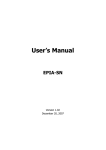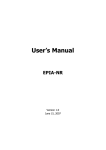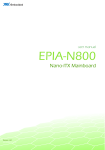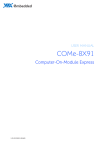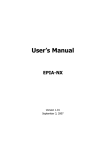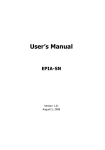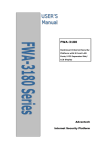Download VIA Technologies NAB-7500 User`s manual
Transcript
User’s Manual NAB-7500 Version 1.01 December 17, 2007 Copyright Copyright © 2007 VIA Technologies Incorporated. All rights reserved. No part of this document may be reproduced, transmitted, transcribed, stored in a retrieval system, or translated into any language, in any form or by any means, electronic, mechanical, magnetic, optical, chemical, manual or otherwise without the prior written permission of VIA Technologies, Incorporated. Trademarks All trademarks are the property of their respective holders. PS/2 is a registered trademark of IBM Corporation. Disclaimer No license is granted, implied or otherwise, under any patent or patent rights of VIA Technologies. VIA Technologies makes no warranties, implied or otherwise, in regard to this document and to the products described in this document. The information provided in this document is believed to be accurate and reliable as of the publication date of this document. However, VIA Technologies assumes no responsibility for the use or misuse of the information in this document and for any patent infringements that may arise from the use of this document. The information and product specifications within this document are subject to change at any time, without notice and without obligation to notify any person of such change. FCC-B Radio Frequency Interference Statement This equipment has been tested and found to comply with the limits for a class B digital device, pursuant to part 15 of the FCC rules. These limits are designed to provide reasonable protection against harmful interference when the equipment is operated in a commercial environment. This equipment generates, uses and can radiate radio frequency energy and, if not installed and used in accordance with the instruction manual, may cause harmful interference to radio communications. Operation of this equipment in a residential area is likely to cause harmful interference, in which case the user will be required to correct the interference at his personal expense. Notice 1 The changes or modifications not expressly approved by the party responsible for compliance could void the user's authority to operate the equipment. Notice 2 Shielded interface cables and A.C. power cord, if any, must be used in order to comply with the emission limits. Tested To Comply With FCC Standards FOR HOME OR OFFICE USE ii SAFETY INSTRUCTIONS Always read the safety instructions carefully. Make sure the voltage of the power source and adjust properly 110/220V before connecting the equipment to the power inlet. Place the power cord in such a way that people cannot step on it. Do not place anything over the power cord. Always unplug the power cord before inserting any add-on card or module. If any of the following situations arises, get the equipment checked by a service personnel: Keep this User's Manual for future reference. Keep this equipment away from humidity. Lay this equipment on a reliable flat surface before setting it up. The openings on the enclosure are for air convection hence protects the equipment from overheating. Do not cover the openings. All cautions and warnings on the equipment should be noted. Never pour any liquid into the opening. Liquid can cause damage or electrical shock. The power cord or plug is damaged. Liquid has penetrated into the equipment. The equipment has been exposed to moisture. The equipment has not worked well or you cannot get it work according to User's Manual. The equipment has dropped and damaged. If the equipment has obvious sign of breakage. Do not leave this equipment in an environment unconditioned or in a o o storage temperature above 60 C (140 F). The equipment may be damaged. Caution: Explosion or serious damage may occur if the battery is incorrectly replaced. Replace only with the same or equivalent battery type recommended by the manufacturer. iii TABLE OF CONTENTS Safety Instructions ........................................................................................................ iii Table of Contents.......................................................................................................... iv C C Chhhaaapppttteeerrr 111 Specifications ..............................................................................................1 Mainboard Specifications.......................................................................................2 Mainboard Layout.....................................................................................................4 Back Panel Layout .....................................................................................................5 C C Chhhaaapppttteeerrr 222 Installation ...................................................................................................6 CPU.................................................................................................................................7 CPU Fan and System Fan: CPUFAN and SYSFAN .....................................7 Memory Module Installation ................................................................................8 Memory Slot: DDR2 DIMM...............................................................................8 DDR2 SDRAM Module Installation Procedures ........................................8 Available DDR2 SDRAM Configurations......................................................9 Connecting the Power Supply........................................................................... 10 ATX 20-Pin Power Connector ....................................................................... 10 Back Panel Ports ..................................................................................................... 11 12V DC Power Jack (manufacturing option) ........................................... 11 Serial port: COM ................................................................................................ 11 USB Ports.............................................................................................................. 11 Gigabit LAN Ports ............................................................................................. 11 Connectors ............................................................................................................... 12 VGA Connector: VGA ....................................................................................... 12 Serial ATA II Connectors: SATA1 to SATA4.............................................. 12 IDE Connector: IDE ........................................................................................... 13 USB Pin Connector: USB_2/3 and USB_4/5.............................................. 14 LAN Activity Led Connector: LAN_LED...................................................... 14 Digital I/O Connector: DIO ............................................................................ 15 System Management Bus Connector: SMBUS ....................................... 15 Serial Port Connector: COM2........................................................................ 15 Case Connector: F_PANEL.............................................................................. 16 Power LED (PWR_LED)..................................................................................... 16 HDD LED (HD_LED)........................................................................................... 16 Power Switch (PW_BN).................................................................................... 16 Speaker (SPEAK) ................................................................................................ 16 Reset Switch (RST_SW).................................................................................... 16 Sleep LED (SLEEP_LED) .................................................................................... 16 KBMS Connector: KB/MS................................................................................ 17 INTRUDER ............................................................................................................ 17 12V DC Connector (manufacturing option) ............................................ 17 Jumpers...................................................................................................................... 18 iv Clear CMOS Connector: CLEAR_CMOS ..................................................... 18 Master/Slave Setting for CF Connector: MS_CF_SEL ............................ 18 Voltage Selector for CF Connector: V_CF_SEL ........................................ 18 Voltage Selector for COM2 Connector: 5V-12V .................................... 19 BIOS Write Protect: WP-1............................................................................... 19 EEPROM Write Protect: WP-2....................................................................... 19 LAN Bypass: BYPASS ........................................................................................ 19 Slots............................................................................................................................. 20 Mini Peripheral Component Interconnect: MiniPCI.............................. 20 PCI Interrupt Request Routing ..................................................................... 20 Compact Flash Type II Connector: CF........................................................ 20 C C Chhhaaapppttteeerrr 333 BIOS Setup................................................................................................ 21 Entering the BIOS Setup Menu ......................................................................... 22 Control Keys............................................................................................................. 23 Navigating the BIOS Menus............................................................................... 24 Getting Help............................................................................................................. 25 Main Menu ............................................................................................................... 26 Standard CMOS Features............................................................................... 26 Advanced BIOS Features ................................................................................ 26 Advanced Chipset Features........................................................................... 26 Integrated Peripherals..................................................................................... 26 Security Chip Configuration .......................................................................... 26 Power Management Setup............................................................................ 26 PnP/PCI Configurations .................................................................................. 27 PC Health Status................................................................................................ 27 Frequency/Voltage Control ........................................................................... 27 Load Fail-Safe Defaults ................................................................................... 27 Load Optimized Defaults................................................................................ 27 Set Supervisor Password ................................................................................ 27 Set User Password ............................................................................................ 27 Save & Exit Setup.............................................................................................. 27 Exit Without Saving .......................................................................................... 27 Standard CMOS Features .................................................................................... 28 Date........................................................................................................................ 28 Time ....................................................................................................................... 28 Halt On.................................................................................................................. 28 IDE Drives.................................................................................................................. 29 IDE Channel 0 Master ...................................................................................... 29 IDE Channel 0 Slave.......................................................................................... 29 Advanced BIOS Features ..................................................................................... 31 Virus Warning..................................................................................................... 31 Quick Power On Self-Test .............................................................................. 31 First Boot Device ............................................................................................... 32 v Second Boot Device ......................................................................................... 32 Third Boot Device.............................................................................................. 32 Boot Other Device ............................................................................................ 33 Boot Up NumLock Status............................................................................... 33 Typematic Rate Setting................................................................................... 33 Typematic Rate (Chars/Sec)........................................................................... 33 Typematic Delay (Msec).................................................................................. 33 Security Option .................................................................................................. 33 MPS Version Control for OS.......................................................................... 33 OS Select for DRAM > 64MB........................................................................ 34 Baud Rate............................................................................................................. 34 Agent after Boot................................................................................................ 34 Video BIOS Shadow ......................................................................................... 34 Full Screen Logo Show.................................................................................... 34 Summary Screen Show ................................................................................... 34 CPU Features............................................................................................................ 35 Delay Prior to Thermal .................................................................................... 35 Thermal Management ..................................................................................... 35 Hard Disk Boot Priority ........................................................................................ 36 Network Boot Priority........................................................................................... 37 Advanced Chipset Features ................................................................................ 38 Video RAM Cacheable..................................................................................... 38 VIA Wireless LAN Support ............................................................................. 38 Disabled LAN Bypass ....................................................................................... 38 AGP & P2P Bridge Control ................................................................................. 39 AGP Aperture Size ............................................................................................ 39 AGP3.0 Mode...................................................................................................... 39 VGA Share Memory Size................................................................................. 39 Direct Frame Buffer .......................................................................................... 39 CPU & PCI Bus Control ........................................................................................ 40 VLink Mode Selection...................................................................................... 40 VLink 8X Support............................................................................................... 40 VIA PWR Management ................................................................................... 40 Integrated Peripherals .......................................................................................... 41 Onboard IDE Channel 0 .................................................................................. 41 IDE HDD Block Mode....................................................................................... 41 SATA Controller ................................................................................................. 41 SATA Controller Mode .................................................................................... 41 OnBoard LAN Boot ROM ............................................................................... 42 Watch Dog Timer Select................................................................................. 42 SuperIO Device ....................................................................................................... 43 Onboard Serial Port 1...................................................................................... 43 Onboard Serial Port 2...................................................................................... 43 vi VIA OnChip IDE Device ........................................................................................ 44 IDE Prefetch Mode............................................................................................ 44 CF Card UDMA66 .............................................................................................. 44 IDE DMA Transfer Access ............................................................................... 44 USB Device Setting ................................................................................................ 45 USB 1.0 Controller............................................................................................. 45 USB 2.0 Controller............................................................................................. 45 USB Operation Mode ...................................................................................... 45 USB Keyboard Function .................................................................................. 45 USB Mouse Function........................................................................................ 46 USB Storage Function...................................................................................... 46 Security Chip Configuration ............................................................................... 47 Security Chip....................................................................................................... 47 Power Management Setup................................................................................. 48 ACPI Suspend Type .......................................................................................... 48 HDD Power Down............................................................................................. 48 Power Management Timer ............................................................................ 48 Video Off Option............................................................................................... 49 Video Off Method............................................................................................. 49 Soft-Off by PWRBTN........................................................................................ 49 Run VGABIOS if S3 Resume........................................................................... 49 AC Loss Auto Restart ....................................................................................... 49 Peripherals Activities............................................................................................. 50 USB Resume........................................................................................................ 50 PowerOn by PCI Card ...................................................................................... 50 RTC Alarm Resume ........................................................................................... 50 PnP/PCI Configurations ....................................................................................... 51 Init Display First ................................................................................................. 51 PNP OS Installed................................................................................................ 51 Reset Configuration Data............................................................................... 51 Resources Controlled By................................................................................. 52 Assign IRQ for VGA .......................................................................................... 52 Assign IRQ for USB ........................................................................................... 52 Maximum Payload Size................................................................................... 52 PC Health Status..................................................................................................... 53 Frequency/Voltage Control ................................................................................ 54 DRAM Clock ........................................................................................................ 54 DRAM Timing ..................................................................................................... 54 Auto Detect PCI Clk.......................................................................................... 54 Spread Spectrum............................................................................................... 54 Load Fail-Safe Defaults ........................................................................................ 55 Load Optimized Defaults..................................................................................... 56 Set Supervisor/User Password........................................................................... 57 vii Set Supervisor..................................................................................................... 57 User Password .................................................................................................... 57 Save & Exit Setup................................................................................................... 59 Exit Without Saving ............................................................................................... 60 C C Chhhaaapppttteeerrr 444 Driver Installation ................................................................................... 61 Driver Utilities .......................................................................................................... 62 Getting Started................................................................................................... 62 Running the Driver Utilities CD .................................................................... 63 CD Content............................................................................................................... 64 viii CHHAAPPTTEERR 1 SPECIFICATIONS The compact and highly integrated VIA NAB-7500 mainboard comes with an integrated VIA C7® NanoBGA2 processor, boasting of ultra-low power consumption and cool operation. 1 Mainboard Specifications CPU • ® VIA C7 1.5GHz NanoBGA2 processor (2.0GHz and 1.0GHz options are also available) Chipset • VIA CN896 North Bridge • VIA VT8251 South Bridge Graphics • Integrated VIA Chrome9™ HC Integrated Graphics with 2D/3D and Video Acceleration Memory • Two DDR2 667/533 DIMM slots (up to 3.5 GB) Expansion Slot • One 32-bit Mini-PCI Type III socket (available for NAB-7500-15TLG) • One 33MHz 32-bit PCI Golden Finger IDE • One UltraDMA 133/100/66 connector (44 pin) LAN • Four VIA VT6130 PCI Express Gigabit Ethernet Controller • One VIA VT6122 Gigabit Ethernet Controller (available for NAB-7500-15TLG) Note: System resources (such as BIOS, PCI, etc.) require physical memory address locations that reduce available memory addresses above 3 GB. This may result in less than 4 GB of memory being available to the operating system and applications. 2 Back Panel I/O Ports • One DB-9 serial port • Five (NAB-7500-15TLG) or four (NAB-7500-15LG) RJ-45 LAN ports • Two USB 2.0 ports Onboard I/O Connectors • One VGA pin connector • One Digital I/O pin connector • One PS/2 keyboard/mouse pin connector • One Front Panel pin connector • One Front Panel LAN LED pin connector for monitoring LAN activity • Two fan connectors for CPU and System fans • Four S-ATA II connectors • One Type II Compact Flash slot • Two USB pin connectors for four additional USB 2.0 ports • One serial port pin connector (5V/12V selectable) • One HDD power pin connector (+5V, +12V) • One ATX power connector • One 12V DC jack (optional) • One 1x4 pin 12V DC connector (optional) Onboard TPM (Trust Platform Module) • Infineon SLB9635TT 1.2 (available for NAB-7500-15TLG) Super IO • Winbond W83697HG BIOS • Award BIOS with LPC 4/8Mbit flash memory capacity Form Factor • 228.6mm X 180mm (six layer) 3 Mainboard Layout 4 Back Panel Layout 5 CHHAAPPTTEERR 2 INSTALLATION This chapter provides you with information about hardware installation procedures. It is recommended to use a grounded wrist strap before handling computer components. Electrostatic discharge (ESD) can damage some components. 6 CPU The VIA NAB-7500 mainboard is packaged with a standard VIA C7® 1.5GHz NanoBGA2 processor. Other processor speeds (i.e., 2.0GHz and ® 1.0GHz) are also available as manufacturing options. The VIA C7 1.5GHz processor requires a heatsink with fan to provide sufficient cooling. CPU Fan and System Fan: CPUFAN and SYSFAN The CPU_FAN (CPU fan) and SYS_FAN (system fan) run on +12V and maintain system cooling. When connecting the wire to the connectors, always be aware that the red wire (positive wire) should be connected to the +12V. The black wire is Ground and should always be connected to GND. Pin 1 2 3 Signal FANIO +12V GND CPU_FAN 7 SYS_FAN Memory Module Installation Memory Slot: DDR2 DIMM The VIA NAB-7500 mainboard provides two 240-DIMM slots for DDR2 667/533 SDRAM memory modules and supports memory sizes up to 3.5GB. DDR2 SDRAM Module Installation Procedures • • • • Locate the DIMM slot in the motherboard. Unlock a DIMM slot by pressing the retaining clips outward. Align a DIMM on the socket such that the notch on the DIMM matches the break on the slot. Firmly insert the DIMM into the slot until the retaining clips snap back in place and the DIMM is properly seated. 8 Available DDR2 SDRAM Configurations Refer to the table below for available DDR2 SDRAM configurations on the mainboard. Slot Module Size DIMM1 64MB, 128MB, 256MB, 512MB, 1GB, 2GB DIMM2 64MB, 128MB, 256MB, 512MB, 1GB, 2GB Maximum supported system memory 9 Total 64MB-2GB 64MB-2GB 64MB-4GB Connecting the Power Supply The VIA NAB-7500 mainboard supports a conventional ATX power supply for the power system. Before inserting the power supply connector, always make sure that all components are installed correctly to ensure that no damage will be caused. ATX 20-Pin Power Connector To connect the power supply, make sure the power plug is inserted in the proper orientation and the pins are aligned. Then push down the plug firmly into the connector. Pin 1 2 3 4 5 6 7 8 9 10 Signal +3.3V +3.3V GND +5V GND +5V GND Power Good +5V Standby +12V Pin 11 12 13 14 15 16 17 18 19 20 10 Signal +3.3V -12V GND Power Supply On GND GND GND -5V +5V +5V Back Panel Ports The back panel has the following ports: 12V DC Power Jack (manufacturing option) The DC power jack is used to connect an external AC adapter as the power source instead of using an ATX power supply. Serial port: COM The 9-pin COM port is for pointing devices or other serial devices. USB Ports Two standard USB 2.0 ports are provided on the back panel. Gigabit LAN Ports The mainboard provides four PCIe Gigabit Ethernet ports controlled with separate VIA VT6130 PCIe Gigabit Ethernet controllers and one Gigabit Ethernet port (available on NAB-7500-15TLG) controlled by a VIA VT6122 Gigabit Ethernet controller. 11 Connectors VGA Connector: VGA This is an interface for connecting the included VGA pin connector cable. Pin 1 3 5 7 9 11 13 Signal GND R G B GND GND GND Pin 2 4 6 8 10 12 14 Signal +5V VGA_SPD2 VGA_SPCLK2 VGA_HS VGA_VS GND KEY Serial ATA II Connectors: SATA1 to SATA4 These next generation connectors support the right angle Serial ATA cables for primary internal storage devices. The current Serial ATA interface allows up to 300MB/s data transfer rate, faster than the standard parallel ATA with 133 MB/s (Ultra DMA). 12 IDE Connector: IDE The mainboard has an Ultra DMA 133/100/66 controller. You can connect up to two IDE devices in any combination. Pin 1 3 5 7 9 11 13 15 17 19 21 23 25 27 29 31 33 35 37 39 41 43 Signal #IDE_RST PD_7 PD_6 PD_5 PD_4 PD_3 PD_2 PD_1 PD_0 GND #PD_REQ #PD_IOW #PD_IOR #PD_RDY #PD_ACK PD_IRQ14 PD_A1 PD_A0 #PD_CS1 #HD_LED1 +5V GND Pin 2 4 6 8 10 12 14 16 18 20 22 24 26 28 30 32 34 36 38 40 42 44 Signal GND PD_8 PD_9 PD_10 PD_11 PD_12 PD_13 PD_14 PD_15 KEY GND GND GND PRIMARY_28 GND NC IDE_DMADET PD_A2 #PD_CS3 GND +5V #TYPE If two drives are connected to a single cable, the jumper on the second drive must be set to slave mode. Refer to the drive documentation supplied by the vendor for the jumper settings. 13 USB Pin Connector: USB_2/3 and USB_4/5 The mainboard provides one 10-pin USB pin connectorand one 12-pin USB pin connector (allowing up to four additional USB 2.0 ports). Therefore mainboard can support up to six USB 2.0 ports. These ports can be used to connect high-speed USB interface peripherals such as USB HDD, digital cameras, MP3 players, printers, modem and the like. 10-Pin USB Pin connector Pin Signal Pin 1 USB_Vcc 2 3 USBD_T04 5 USBD_T0+ 6 7 GND 8 9 KEY 10 12-Pin USB Pin connector Pin Signal Pin 1 USB_Vcc 2 3 USBD_T44 5 USBD_T4+ 6 7 GND 8 9 11 KEY GND 10 12 Signal USB_VCC USBD_T1USBD_T1+ GND GND Signal USB_VCC USBD_T5USBD_T5+ GND WLAN_LED GPO_9 LAN Activity Led Connector: LAN_LED This pin connector is for LPC devices. Pin 1 3 5 7 9 11 13 15 Signal BY_LED LAN1_LNK_ACT LAN2_LNK_ACT LAN3_LNK_ACT LAN4_LNK_ACT LAN5_LNK_ACT NC WLAN_LED Pin 2 4 6 8 10 12 14 16 Signal +5V VDD33-1 VDD33-2 VDD33-3 VDD33-4 VDDIO KEY +3.3VSUS 14 Digital I/O Connector: DIO General purpose digital input and output. Pin 1 3 5 7 9 11 Signal 5V_DIO GPO_1 GPO_4 GPO_6 GPO_7 GND Pin 2 4 6 8 10 12 Signal 12V_DIO GPI_32 GPI_33 GPI_34 GPI_22 GND System Management Bus Connector: SMBUS This pin header allows you to connect SMBus (System Management Bus) devices. Devices communicate with a SMBus host and/or other SMBus devices using the SMBus interface. Pin 1 2 3 Signal SMBCK SMBDT GND Serial Port Connector: COM2 COM2 pin header can be used to attach an additional port for serial devices. Pin 1 3 5 7 9 Signal COM_DCD COM_TXD GND COM_RTS COM_RI Pin 2 4 6 8 10 Signal COM_RXD COM_DTR COM_DSR COM_CTS KEY 15 Case Connector: F_PANEL The F_PANEL pin header allows you to connect the power switch, reset switch, power LED, sleep LED, HDD LED and the case speaker. Pin 1 3 5 7 9 11 13 15 Signal +PWR_LED +PWR_LED -PWR_LED SPEAK+ NC NC SPEAKKEY Pin 2 4 6 8 10 12 14 16 Signal +HD_LED -HD_LED PW_BN GND RST_SW GND +SLEEP_LED -SLEEP_LED Power LED (PWR_LED) The LED will light when the system is on. If the system is in S1 (POS Power On Suspend) or S3 (STR - Suspend To RAM) state, the LED will blink. HDD LED (HD_LED) HDD LED shows the activity of a hard disk drive. Avoid turning the power off when the HDD LED is still on. Connect the HDD LED from the system case to this pin. Power Switch (PW_BN) Connect to a 2-pin power button switch. Pressing this button will turn the system power on or off. Speaker (SPEAK) The speaker from the system case is connected to this pin. Reset Switch (RST_SW) The reset switch is used to reboot the system rather than turning the power ON/OFF. Avoid rebooting the system, if the HDD is still working. Connect the reset switch from the system case to this pin. Sleep LED (SLEEP_LED) The SLEEP LED is lit when the system is in the S1 (POW-Power On Suspend) 16 KBMS Connector: KB/MS The mainboard provides a PS2 pin header to attach a PS2 keyboard and mouse. Pin 1 3 5 7 9 Signal +5V NC GND KB_DT KB_CK Pin 2 4 6 8 10 Signal GND KEY GND MS_DT MS_CK INTRUDER This pin connector is for chassis intrusion switch connector. This is not a default function supported by BIOS. Pin 1 2 3 Signal NC INTRUDER GND 12V DC Connector (manufacturing option) This connector is for providing an interface for external power source designs. Pin 1 2 3 4 Signal +12V GND GND NC 17 Jumpers The mainboard provides jumpers for setting some mainboard functions. This section will explain how to change the settings of the mainboard functions using the jumpers. Clear CMOS Connector: CLEAR_CMOS The onboard CMOS RAM stores system configuration data and has an onboard battery power supply. To reset the CMOS settings, set the jumper on pins 1 and 2 while the system is off. Return the jumper to pins 2 and 3 afterwards. Setting the jumper while the system is on will damage the mainboard. Setting Normal Operation Clear CMOS setting 1 ON OFF 2 ON ON 3 OFF ON Warning: Except when clearing the RTC RAM, never remove the cap on CLEAR_CMOS jumper default position. Removing the cap will cause system boot failure. Avoid clearing the CMOS while the system is on; it will damage the mainboard. Master/Slave Setting for CF Connector: MS_CF_SEL This jumper determines the working state of the CF connector. The default value is Master. Setting Slave Master 1 ON OFF 2 ON ON 3 OFF ON Voltage Selector for CF Connector: V_CF_SEL This VCC selector jumper is to determine the input voltage of the CF connector. The default value is +3.3V. Setting +3.3V +5V 1 ON OFF 2 ON ON 3 OFF ON 18 Voltage Selector for COM2 Connector: 5V-12V This VCC selector is to determine the input voltage of each COM connector. Setting +5V +12V Normal (default) 1 ON OFF OFF 2 ON OFF ON 3 OFF ON ON 4 OFF ON OFF BIOS Write Protect: WP-1 This jumper enables or disables the Write Protect function for the BIOS. Setting Normal (default) Write Protect 1 ON OFF 2 ON ON 3 OFF ON EEPROM Write Protect: WP-2 This jumper enables or disables the Write Protect function for the EEPROM. Setting Normal (default) Write Protect 1 ON OFF 2 ON ON 3 OFF ON LAN Bypass: BYPASS This jumper enables or disables the LAN bypassing function. Setting Enable (default) Disable 1 ON OFF 2 ON ON 3 OFF ON 19 Slots Mini Peripheral Component Interconnect: MiniPCI The MiniPCI slot allows you to insert a MiniPCI expansion card. First unplug the power supply before adding or removing expansion cards. Read the documentation for the expansion card to see if any changes to the system are necessary. PCI Interrupt Request Routing The IRQ (interrupt request line) are hardware lines over which devices can send interrupt signals to the microprocessor. The “PCI & LAN” IRQ pins are typically connected to the PCI bus INT A# ~ INT D# pins as follows: MiniPCI Slot Order 1 INT B# Order 2 INT C# Order 3 INT D# Order 4 INT A# Compact Flash Type II Connector: CF This CF connector allows you to connect to a passive 50-pin Type II adapter. 20 CHHAAPPTTEERR 3 BIOS SETUP This chapter gives a detailed explanation of the BIOS setup functions. 21 Entering the BIOS Setup Menu Power on the computer and press <Delete> during the beginning of the boot sequence to enter the BIOS setup menu. If you missed the BIOS setup entry point, restart the system and try again. 22 Control Keys Keys Description Move to the previous item Move to the next item Move to the item in the left side Move to the item in the right side Select the item Enter Esc Page Up Page Down Jumps to the Exit menu or returns to the main menu from a submenu Increase the numeric value or make changes Decrease the numeric value or make changes Increase the numeric value or make changes - Decrease the numeric value or make changes F1 General help, only for Status Page Setup Menu and Option Page Setup Menu F5 Restore the previous CMOS value from CMOS, only for Option Page Setup Menu F6 F7 F10 Load the default CMOS value from Fail-Safe default table, only for Option Page Setup Menu Load Optimized defaults Save all the CMOS changes and exit 23 Navigating the BIOS Menus The main menu displays all the BIOS setup categories. Use the <Left>/<Right> and <Up>/<Down> arrow keys to select any item or sub-menu. Descriptions of the selected/highlighted category are displayed at the bottom of the screen. An arrow symbol next to a field indicates that a sub-menu is available (see figure below). Press <Enter> to display the sub-menu. To exit the sub-menu, press <Esc>. 24 Getting Help The BIOS setup program provides a “General Help” screen. You can display this screen from any menu/sub-menu by pressing <F1>. The help screen displays the keys for using and navigating the BIOS setup. Press <Esc> to exit the help screen. 25 Main Menu The Main Menu contains thirteen setup functions and two exit choices. Use arrow keys to select the items and press <Enter> to accept or enter Sub-menu. Standard CMOS Features Use this menu to set basic system configurations. Advanced BIOS Features Use this menu to set the advanced features available on your system. Advanced Chipset Features Use this menu to set chipset specific features and optimize system performance. Integrated Peripherals Use this menu to set onboard peripherals features. Security Chip Configuration Use this menu to configure the security features. Power Management Setup Use this menu to set onboard power management functions. 26 PnP/PCI Configurations Use this menu to set the PnP and PCI configurations. PC Health Status This menu shows the PC health status. Frequency/Voltage Control Use this menu to set the system frequency and voltage control. Load Fail-Safe Defaults Use this menu option to load the BIOS default settings for minimal and stable system operations. Load Optimized Defaults Use this menu option to load BIOS default settings for optimal and high performance system operations. Set Supervisor Password Use this menu option to set the BIOS supervisor password. Set User Password Use this menu option to set the BIOS user password. Save & Exit Setup Save BIOS setting changes and exit setup. Exit Without Saving Discard all BIOS setting changes and exit setup. 27 Standard CMOS Features Date The date format is [Day, Month Date, Year] Time The time format is [Hour : Minute : Second] Halt On Set the system’s response to specific boot errors. Below is a table that details the possible settings. Settings Description All Errors No Errors All, But Keyboard System halts when any error is detected System does not halt for any error System halts for all non-key errors 28 IDE Drives IDE Channel 0 Master IDE Channel 0 Slave 29 The specifications of your drive must match with the drive table. The hard disk will not work properly if you enter incorrect information in this category. Select “Auto” whenever possible. If you select “Manual”, make sure the information is from your hard disk vendor or system manufacturer. Below is a table that details required hard drive information when using the “Manual” mode. Settings Description IDE Channel The name of this match the name of the menu. Settings: [None, Auto, Manual] Settings: [CHS, LBA, Large, Auto] Formatted size of the storage device Number of cylinders Number of heads Write precompensation Cylinder location of the landing zone Number of sectors Settings: [ Auto, Mode 1, Mode 2, Mode 3, Mode 4] Settings: [Disabled, Auto] Access Mode Capacity Cylinder Head Precomp Landing Zone Sector Primary PIO Primary UDMA 30 Advanced BIOS Features Virus Warning Allows you to choose the VIRUS warning feature for IDE Hard Disk boot sector protection. Settings Description Enabled Disabled Turns on hard disk boot sector virus protection Turns off hard disk boot sector virus protection Note: If this function is enabled and someone attempt to write data into this area, BIOS will show a warning message on the screen and alarm beep. Quick Power On Self-Test Shortens Power On Self-Test (POST) cycle to enable shorter boot up time. Settings Description Disabled Enabled Standard Power On Self Test (POST) Shorten Power On Self Test (POST) cycle and boot up time 31 First Boot Device Set the boot device sequence as BIOS attempts to load the disk operating system. Settings Description Removable Hard Disk CDROM USB-CDROM Network Disabled Boot from external drive Boot from the HDD Boot from CDROM Boot from USB CDROM Boot from network drive Disable the boot device sequence Second Boot Device Set the boot device sequence as BIOS attempts to load the disk operating system. Settings Description Removable Hard Disk CDROM USB-CDROM Network Disabled Boot from external drive Boot from the HDD Boot from CDROM Boot from USB CDROM Boot from network drive Disable the boot device sequence Third Boot Device Set the boot device sequence as BIOS attempts to load the disk operating system. Settings Description Removable Hard Disk CDROM USB-CDROM Network Disabled Boot from external drive Boot from the HDD Boot from CDROM Boot from USB CDROM Boot from network drive Disable the boot device sequence 32 Boot Other Device Enables the system to boot from alternate devices if the system fails to boot from the “First/Second/Third Boot Device” lists. Settings Description Disabled Enabled No alternate boot device allowed Enable alternate boot device Boot Up NumLock Status Set the NumLock status when the system is powered on. Settings Description Off On Forces keypad to behave as arrow keys Forces keypad to behave as 10-key Typematic Rate Setting Enable “Typematic Rate” function. Settings: [Disabled, Enabled] Typematic Rate (Chars/Sec) This item sets the rate (characters/second) at which the system retrieves a signal from a depressed key. Settings: [6, 8, 10, 12, 15, 20, 24, 30] Typematic Delay (Msec) This item sets the delay between, when the key was first pressed and when the system begins to repeat the signal from the depressed key. Settings: [250, 500, 750, 1000] Security Option Selects whether the password is required every time the System boots, or only when you enter Setup. Settings Description Setup System Password prompt appears only when end users try to run BIOS Setup Password prompt appears every time when the computer is powered on and when end users try to run BIOS Setup MPS Version Control for OS Settings: [1.1, 1.4] 33 OS Select for DRAM > 64MB Select OS2 only if you are running OS/2 operating system with greater than 64MB of RAM on the system. Settings: [Non-OS2, OS2] Baud Rate Settings: [9600, 19200, 38400, 57600, 115200] Agent after Boot Settings: [Disabled, Enabled] Video BIOS Shadow Enabled copies Video BIOS to shadow RAM Improves performance. Settings: [Disabled, Enabled] Full Screen Logo Show Show full screen logo during BIOS boot up process. Settings: [Disabled, Enabled] Summary Screen Show Show summary screen. Settings: [Disabled, Enabled] 34 CPU Features Delay Prior to Thermal Settings: [4 Min, 8 Min, 16 Min, 32 Min] Thermal Management This item sets CPU’s thermal control rule to protect CPU from overheat. Settings Description Thermal Monitor 1 Thermal Monitor 2 On-die throtting Ratio & VID transition 35 Hard Disk Boot Priority This is for setting the priority of the hard disk boot order when the “Hard Disk” option is selected in the “[First/Second/Third] Boot Device” menu item. 36 Network Boot Priority This is for setting the boot order of the connected networks. 37 Advanced Chipset Features Warning: The Advanced Chipset Features menu is used for optimizing the chipset functions. Do not change these settings unless you are familiar with the chipset. Video RAM Cacheable Settings: [Disabled, Enabled] VIA Wireless LAN Support Settings: [Enabled, Disabled] Disabled LAN Bypass Settings: [Disabled, Enabled] 38 AGP & P2P Bridge Control AGP Aperture Size This setting controls how much memory space can be allocated to AGP for video purposes. The aperture is a portion of the PCI memory address range dedicated to graphics memory address space. Host cycles that hit the aperture range are forwarded to the AGP without any translation. Settings: [32MB, 64MB, 128MB, 256MB, 512MB, 1GB] AGP3.0 Mode This mainboard supports the AGP 8x interface. When the AGP 8x video card is used, it can transfer video data at 2133MB/s. AGP 8x is backward compatible, leave the default 4x mode on. AGP 4x mode can be detected automatically once you plug in the AGP 4x card. Settings: [8x, 4x] VGA Share Memory Size This setting allows you to select the amount of system memory that is allocated to the integrated graphics processor. Settings: [Disabled, 64M, 128M, 256M] Direct Frame Buffer Settings: [Disabled, Enabled] 39 CPU & PCI Bus Control VLink Mode Selection Settings: [By Auto, Mode 0, Mode 1, Mode 2, Mode 3, Mode 4] VLink 8X Support Settings: [Disabled, Enabled] VIA PWR Management Settings: [Disabled, Enabled] 40 Integrated Peripherals Onboard IDE Channel 0 Settings: [Disabled, Enabled] IDE HDD Block Mode Automatic detection of the optimal number of block read/writes per sector the drive can support. Settings: [Disabled, Enabled] SATA Controller Settings: [Disabled, Enabled] SATA Controller Mode Controls the features of the Serial ATA controller within the South Bridge. Serial ATA is the latest generation of the ATA interface. Serial ATA hard drives deliver transfer speeds of up to 300MB/sec. Settings Description IDE Supports two PATA hard disk drives. Disables RAID and AHCI function. RAID Only SATA supports RAID and AHCI function AHCI Enable the AHCI function such as Native Command Queuing and Hot Plug function 41 OnBoard LAN Boot ROM Decide whether to invoke the boot ROM of the onboard LAN chip. Settings: [Enabled, Disabled] Watch Dog Timer Select Settings: [Disabled, 10 sec, 20 sec, 30 sec, 40sec, 1 Min, 2 Min, 4 Min] 42 SuperIO Device Onboard Serial Port 1 Settings: [Disabled, 3F8/IRQ4, 2F8/IRQ3, 3E8/IRQ4, 2E8/IRQ3, Auto] Onboard Serial Port 2 Settings: [Disabled, 3F8/IRQ4, 2F8/IRQ3, 3E8/IRQ4, 2E8/IRQ3, Auto] 43 VIA OnChip IDE Device IDE Prefetch Mode Settings: [Disabled, Enabled] CF Card UDMA66 To support only UDMA66 CF Card Settings: [Disabled, Enabled] IDE DMA Transfer Access Settings: [Disabled, Enabled] 44 USB Device Setting USB 1.0 Controller Enable or disable Universal Host Controller Interface for Universal Serial Bus. Settings: [Disabled, Enabled] USB 2.0 Controller Enable or disable Enhanced Host Controller Interface for Universal Serial Bus. Settings: [Disabled, Enabled] USB Operation Mode Auto decide USB device operation mode. Settings Description Full/Low Speed High Speed All of USB Device operated on full/low speed mode If USB device was high speed device, then it operated on high speed mode. USB Keyboard Function Enable or disable Legacy support of USB Keyboard. Settings: [Disabled, Enabled] 45 USB Mouse Function Enable or disable Legacy support of USB Mouse. Settings: [Disabled, Enabled] USB Storage Function Enable or disable Legacy support of USB Mass Storage. Settings: [Disabled, Enabled] 46 Security Chip Configuration Security Chip Enable or disable security chip. Settings: [Disabled, Enabled] 47 Power Management Setup ACPI Suspend Type Settings Description S1(POS) S1/Power On Suspend (POS) is a low power state. In this state, no system context (CPU or chipset) is lost and hardware maintains all system contexts. S3/Suspend To RAM (STR) is a power-down state. In this state, power is supplied only to essential components such as main memory and wakeup-capable devices. The system context is saved to main memory, and context is restored from the memory when a "wakeup" event occurs. Depends on the OS to select S1 or S3. S3(STR) S1 & S3 HDD Power Down Set the length of time for a period of inactivity before powering down the hard disk. Settings: [Disable, 1 Min, 2 Min, 3 Min, 4 Min, 5 Min, 6 Min, 7 Min, 8 Min, 9 Min, 10 Min, 11 Min, 12 Min, 13 Min, 14 Min, 15 Min] Power Management Timer Settings: [Disable, 1 Min, 2 Min, 4 Min, 6 Min, 8 Min, 10 Min, 20 Min, 30 Min, 40 Min, 1 Hour] 48 Video Off Option Select whether or not to turn off the screen when system enters power saving mode, ACPI OS such as Windows XP will override this option. Settings Description Always On Screen is always on even when system enters power saving mode Screen is turned off when system enters power saving mode Suspend -> Off Video Off Method Settings: [Blank Screen, V/H SYNC+Blank, DPMS Support] Soft-Off by PWRBTN Settings Description Delay 4 Sec System is turned off if power button is pressed for more than four seconds. Power button functions as a normal power-on/-off button. Instant-Off Run VGABIOS if S3 Resume Select whether to run VGA BIOS if resuming from S3 state. This is only necessary for older VGA drivers. Settings: [Auto, Yes, No] AC Loss Auto Restart The field defines how the system will respond after an AC power loss during system operation. Settings Description Off On Former-Sts Keeps the system in an off state until the power button is pressed Restarts the system when the power is back Former-Sts 49 Peripherals Activities USB Resume Settings: [Disabled, Enabled] PowerOn by PCI Card Enables activity detected from any PCI card to power up the system or resume from a suspended state. Such PCI cards include LAN, onboard USB ports, etc. Settings: [By OS, Enabled] RTC Alarm Resume Set a scheduled time and/or date to automatically power on the system. Settings: [Disabled, Enabled] 50 PnP/PCI Configurations Note: This section covers some very technical items and it is strongly recommended to leave the default settings as is unless you are an experienced user. Init Display First Settings: [PCI Slot, Onboard, PCIEx] PNP OS Installed Settings Description No Yes BIOS will initialize all the PnP cards BIOS will only initialize the PnP cards used for booting (VGA, IDE, SCSI). The rest of the cards will be initialized by the PnP operating system Reset Configuration Data Settings Description Disabled Enabled Default setting Resets the ESCD (Extended System Configuration Data) after exiting BIOS Setup if a newly installed PCI card or the system configuration prevents the operating system from loading 51 Resources Controlled By Enables the BIOS to automatically configure all the Plug-and-Play compatible devices. Settings Description Auto(ESCD) BIOS will automatically assign IRQ, DMA and memory base address fields Unlocks “IRQ Resources” for manual configuration Manual Assign IRQ for VGA Assign IRQ for VGA devices. Settings: [Disabled, Enabled] Assign IRQ for USB Assign IRQ for USB devices. Settings: [Disabled, Enabled] Maximum Payload Size Set maximum TLP payload size for the PCI Express devices. The unit is byte. Settings: [128, 256, 512, 1024, 2048, 4096] 52 PC Health Status The PC Health Status displays the current status of all of the monitored hardware devices/components such as CPU voltages, temperatures and fan speeds. 53 Frequency/Voltage Control DRAM Clock The chipset supports synchronous and asynchronous mode between host clock and DRAM clock frequency. Settings: [By SPD, 200MHz, 266MHz, 333MHz] DRAM Timing The value in this field depends on the memory modules installed in your system. Changing the value from the factory setting is not recommended unless you install new memory that has a different performance rating than the original modules. Settings: [Manual, Auto By SPD] Auto Detect PCI Clk Settings: [Enabled, Disabled] Spread Spectrum When the mainboard's clock generator pulses, the extreme values (spikes) of the pulses create EMI (Electromagnetic Interference). The Spread Spectrum function reduces the EMI generated by modulating the pulses so that the spikes of the pulses are reduced to flatter curves. Settings: [Disabled, Enabled] 54 Load Fail-Safe Defaults This option is for restoring all the default fail-safe BIOS settings. These values are set by the mainboard manufacturer to provide a stable system with basic performance. Entering “Y” and press <Enter> to load the default fail-safe BIOS values. Entering “N” and press <Enter> will cancel the load fail-safe defaults request. 55 Load Optimized Defaults This option is for restoring all the default optimized BIOS settings. The default optimized values are set by the mainboard manufacturer to provide a stable system with optimized performance. Entering “Y” and press <Enter> to load the default optimized BIOS values. Entering ”N” will cancel the load optimized defaults request. 56 Set Supervisor/User Password Set Supervisor User Password This option is for setting a password for entering BIOS Setup. When a password has been set, a password prompt will be displayed whenever BIOS Setup is run. This prevents an unauthorized person from changing any part of your system configuration. 57 There are two types of passwords you can set. A supervisor password and a user password. When a supervisor password is used, the BIOS Setup program can be accessed and the BIOS settings can be changed. When a user password is used, the BIOS Setup program can be accessed but the BIOS settings cannot be changed. To set the password, type the password (up to eight characters in length) and press <Enter>. The password typed now will clear any previously set password from CMOS memory. The new password will need to be reentered to be confirmed. To cancel the process press <Esc>. To disable the password, press <Enter> when prompted to enter a new password. A message will show up to confirm disabling the password. To cancel the process press <Esc>. Additionally, when a password is enabled, the BIOS can be set to request the password each time the system is booted. This would prevent unauthorized use of the system. See “Security Option” in the “Advanced BIOS Features” section for more details. 58 Save & Exit Setup Entering “Y” saves any changes made, and exits the program. Entering “N” will cancel the exit request. 59 Exit Without Saving Entering “Y’ discards any changes made, and exits the program. Entering “N” will cancel the exit request. 60 CHHAAPPTTEERR 4 DRIVER INSTALLATION This chapter gives you brief descriptions of each mainboard driver and application. You must install the VIA chipset drivers first before installing other drivers such as VGA drivers. The applications will only function correctly if the necessary drivers are already installed. 61 Driver Utilities Getting Started VIA NAB-7500 Developer kits include a Driver CD that contains the drivers and software for enhancing the performance of the mainboard. Regular kits do not include a Driver CD. However, the latest drivers can be downloaded from http://www.via.com.tw. Note: The driver utilities and software are updated from time to time. The latest updated versions are available at http://www.via.com.tw 62 Running the Driver Utilities CD To start using the CD, insert the CD into the CD-ROM or DVD-ROM drive. The CD should run automatically after closing the CD-ROM or DVD-ROM drive. The driver utilities and software menu screen should then appear on the screen. If the CD does not run automatically, click on the “Start” button and select “Run…” Then type: "D:\Setup.exe". For Linux drivers, click the right button on mouse and click open. Linux drivers are located in the "Driver" folder. Note: D: might not be the drive letter of the CD-ROM/DVD-ROM in your system. 63 CD Content VIA 4in1 Drivers: Contains VIA ATAPI Vendor Support Driver (enables the performance enhancing bus mastering functions on ATAcapable Hard Disk Drives and ensures IDE device compatibility), AGP VxD Driver (provides service routines to your VGA driver and interface directly to hardware, providing fast graphical access), IRQ Routing Miniport Driver (sets the system's PCI IRQ routing sequence) and VIA INF Driver (enables the VIA Power Management function). Includes V-RAID and RAID tools. VIA Graphics Driver: Enhances the onboard VIA graphic chip. WinXP and Linux Fedora Core 4 drivers are provided. VIA USB 2.0 Driver: Enhances VIA USB 2.0 ports. VIA GigaLAN Driver: Enhances the onboard VIA VT6130 10/100/1000M PCIe Gigabit LAN chips and the VIA VT6122 Gigabit LAN chip (NAB-750015TLG). WinXP and Linux Fedora Core 4 drivers are provided. VIA Linux RAID Driver: Support for RAID devices. For Linux Fedora Core 4 and patch guide to enable PATA/IDE DMA mode for VIA South Bridges. 64










































































